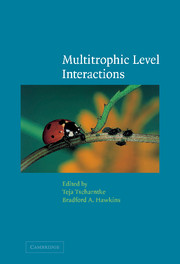Book contents
- Frontmatter
- Contents
- List of contributors
- 1 Multitrophic level interactions: an introduction
- 2 Plant genetic variation in tritrophic interactions
- 3 Multitrophic/multispecies mutualistic interactions: the role of non-mutualists in shaping and mediating mutualisms
- 4 Tritrophic interactions in tropical versus temperate communities
- 5 Endophytic fungi and interactions among host plants, herbivores, and natural enemies
- 6 Multitrophic interactions in space: metacommunity dynamics in fragmented landscapes
- 7 The chemical ecology of plant–caterpillar–parasitoid interactions
- 8 Canopy architecture and multitrophic interactions
- 9 Tritrophic below- and above-ground interactions in succession
- 10 Multitrophic interactions in decomposer food-webs
- Index
5 - Endophytic fungi and interactions among host plants, herbivores, and natural enemies
Published online by Cambridge University Press: 08 August 2009
- Frontmatter
- Contents
- List of contributors
- 1 Multitrophic level interactions: an introduction
- 2 Plant genetic variation in tritrophic interactions
- 3 Multitrophic/multispecies mutualistic interactions: the role of non-mutualists in shaping and mediating mutualisms
- 4 Tritrophic interactions in tropical versus temperate communities
- 5 Endophytic fungi and interactions among host plants, herbivores, and natural enemies
- 6 Multitrophic interactions in space: metacommunity dynamics in fragmented landscapes
- 7 The chemical ecology of plant–caterpillar–parasitoid interactions
- 8 Canopy architecture and multitrophic interactions
- 9 Tritrophic below- and above-ground interactions in succession
- 10 Multitrophic interactions in decomposer food-webs
- Index
Summary
Introduction
Plant-associated microbes are well known for mediating interactions between plants, herbivores, and natural enemies. Plant pathogens may increase or decrease host resistance to invertebrate herbivores and alter attack by natural enemies of the herbivores (e.g., Hatcher, 1995). Mycorrhizal associations alter plant nutrition and growth and thus indirectly influence herbivores feeding upon host plants (e.g., Gehring and Whitham, 1994; Gehring et al., 1997) as well as their natural enemies. Endophytic fungi (fungi that live asymptomatically within plants, at least for part of their life cycle), however, are the only plant-associated microorganisms that are postulated to directly increase host plant defenses against both vertebrate and invertebrate herbivores (Carroll, 1988; Clay, 1988). Endophytic fungi have been considered as “acquired chemical defenses” (Cheplick and Clay, 1988) in grasses and “inducible defenses” and herbivore “antagonists” in woody plants (Carroll, 1988, 1991).
Endophytic fungi are very abundant and often extremely diverse in both woody (e.g., Carroll, 1991; Faeth and Hammon, 1997 a, b; Stone and Petrini, 1997; Arnold et al., 2000) and grass host plants (Leuchtmann, 1992; Saikkonen et al., 1998; Schulthess and Faeth, 1998). The main mechanism for increased plant resistance to herbivores is the production of mycotoxins. Additionally, endophytes may also alter plant physiology and morphology (Clay, 1990; Bacon, 1993), similar to mycorrhizal associations.
- Type
- Chapter
- Information
- Multitrophic Level Interactions , pp. 89 - 123Publisher: Cambridge University PressPrint publication year: 2002
- 51
- Cited by

